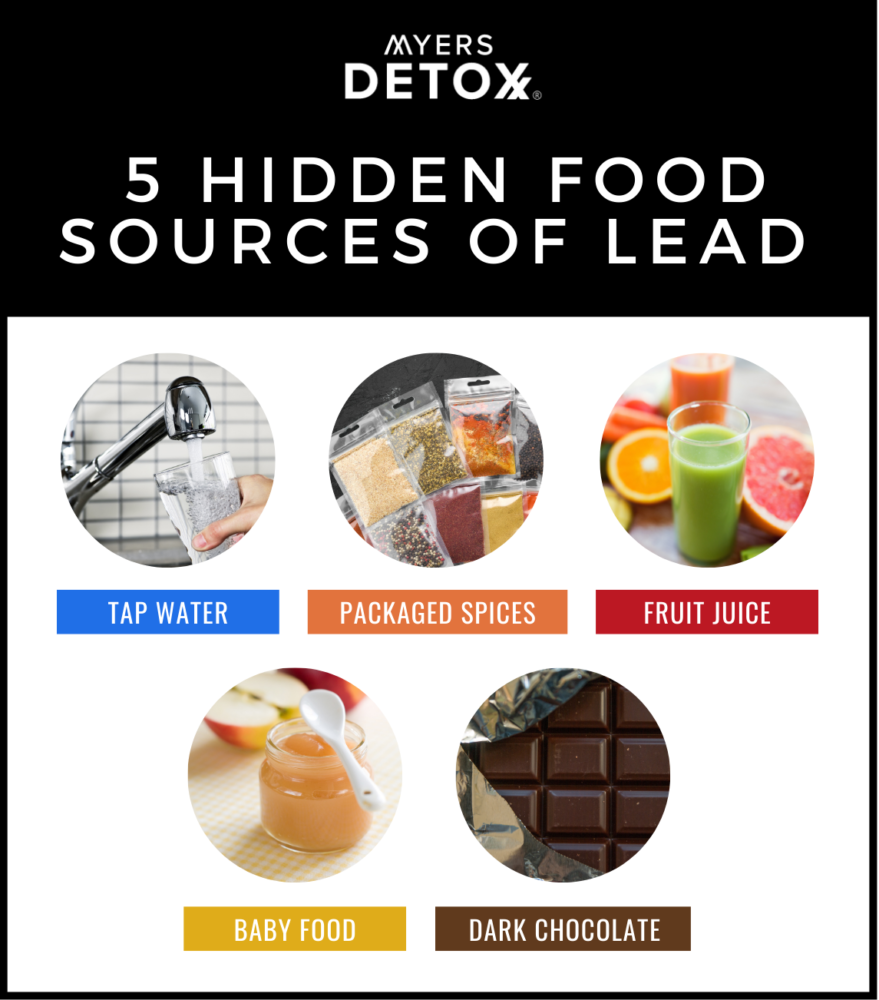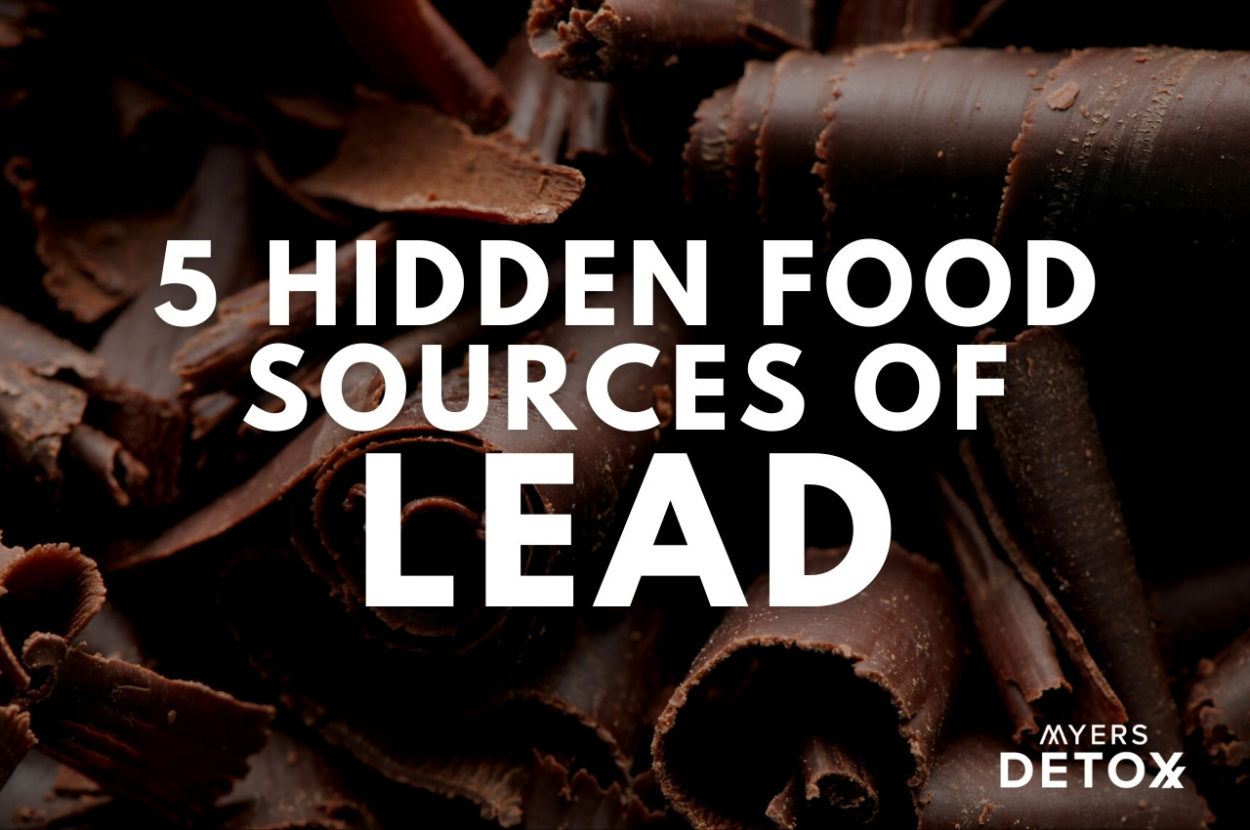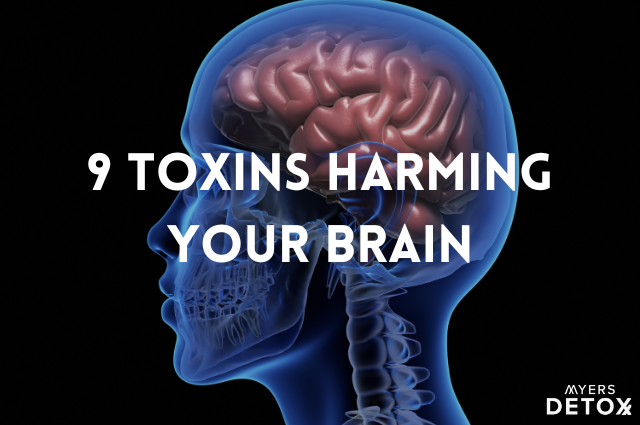Lead is one of the more common heavy metals in our environment. It’s in gasoline, and diesel exhaust, and other types of air pollution, and as a result, most of us are exposed to it every day.
Over time, lead accumulates in your bones and brain, causing a variety of symptoms [1]. Common signs of lead toxicity include:
- Brain fog
- Headaches
- Fatigue
- Lowered IQ
- Vision loss
- Memory loss
- Cognitive dysfunction
- Declining bone health
In recent years, researchers have discovered that a lot of foods contain lead. Here’s a look at some hidden dietary sources of lead, as well as how to detect how much lead is in your body so you can take actionable steps to protect yourself from further exposure.

1. Tap Water
Much of the water infrastructure in the U.S. was installed in one of three timelines: the early 1900s, 1930s, or the 1950s. In the two earlier timelines, the infrastructure was made from lead pipes [2].
Years later (more than 100 years later, in many cases), those pipes are beginning to deteriorate, leaching lead into our drinking water. Many of these pipes are made from galvanized steel, which contains lead and leaches lead into the water entering our homes.
There are two catastrophic cases of tap water infrastructure failing in recent decades: Washington, D.C. and Flint, Michigan.
In 2000, officials discovered that Washington’s outdated lead water pipes were corroding, and that thousands of residents were exposed to high levels of lead [3].
After four years, the local government claimed to have fixed the problem, but in 2011, a study came out showing that their attempts to remove old lead piping had made D.C.’s drinking water even more toxic [4].
A similar case of lead poisoning happened in Flint, Michigan. In 2014, officials discovered that Flint’s drinking water contained dangerously high levels of heavy metals, and that the majority of the town, including about 12,000 children, had developed lead toxicity [5].
As of 2020, Flint is still replacing residents’ lead pipes with copper ones, and Flint’s drinking water still isn’t entirely safe [6].
These cities are getting press from their lead problems, but the reality is that thousands of towns have issues with lead in their water. A 2016 study found that about 30% of water infrastructure in the U.S. is made of aging lead pipes [7], and a 2012 report from the National Institutes of Health raised concerns that replacing lead piping could knock lead into drinking water and cause widespread toxicity [3].
Tap water just isn’t worth the risk. To avoid lead toxicity, get a water filter for your kitchen sink, or buy spring water bottled in glass.
2. Packaged Spices (Especially from India)
In 2010, Boston hospitals noticed that they were getting a disproportionate number of lead poisoning cases in Indian children. Researchers interviewed the families and discovered a common thread: the households cooked with spices imported from India.
The researchers then bought close to a hundred samples of imported spices, including fenugreek, cardamom, turmeric, garlic powder, ginger powder, ground chili, and more, and tested them for lead contamination.
Close to 30% of the samples were heavily contaminated with lead [8].
A 2018 study in North Carolina found similar results — spices imported from India were at increased risk of lead contamination [9].
Check the labels on your spices; you may want to avoid buying ones that were grown or processed in India or China.
The reasoning is two fold to avoid spices from India and China in my opinion. One, spice sellers are known to add lead to the spices to increase the weight and therefore their income from selling the spices. The areas and soil in which the spices are grown can contain high levels of lead due to leaded gasoline being emitted from cars that then settle into the soil in which food is grown and pesticides that contain lead.
3. Fruit Juice
Every few years, the FDA does a massive analysis of food safety across the United States called the Total Diet Study. As of 1970, they’ve tracked heavy metals and pesticides in food.
A recent analysis of the FDA’s Total Diet Study data found that fruit juice is a common source of low-level lead exposure.
Three types of fruit juice were particularly bad when it came to lead content [10]:
- Grape juice –– 89% of samples contained lead
- Mixed fruit juice –– 67% of samples contained lead
- Apple juice –– 55% of samples contained lead
- Pear juice –– 45% of samples contained lead
Grape juice and apple juice are two of the most popular fruit juices in the United States, and they’re also two of the most contaminated foods when it comes to lead content. Make sure you avoid them to keep your lead exposure to a minimum.
4. Baby Food
A 2019 analysis of the FDA’s Total Diet Study data discovered that close to 20% of the 2,164 baby food samples tested contained lead [11].
The worst offenders were fruit-based baby foods (especially those containing grape, apple, and/or pear), baby foods containing sweet potatoes or carrots, and arrowroot teething biscuits.
Lead is especially damaging to children’s brains and can permanently decrease IQ [12]. Always choose organic baby food for your child, or make your own from fresh fruits and vegetables.
5. Dark Chocolate
A 2018 study found that many tested cocoa powder samples had high levels of lead and cadmium contamination [13].
The study also found that cocoa grown in Brazil, Nigeria, and Cameroon was at the highest risk of contamination, while cocoa grown in Ghana, Côte D’Ivoire, Mexico, and Indonesia was at lower risk of contamination.
Dark chocolate is great for you — it’s packed with antioxidants and theobromine, a brain-boosting nutrient you won’t find in many other common foods [14]. I eat it quite a bit as a healthy superfood treat!
However, to minimize your exposure to lead and other heavy metals, you should avoid chocolate that originates from Brazil, Nigeria, or Cameroon.
The Primary Reasons Lead Is Everywhere In Our Food Supply
One of the primary reasons that lead exists so ubiquitously in our food supply is due to pesticides. Although many states have begun regulations around lead contamination, research shows that the pesticides that are sprayed on crops still contain dangerous levels of heavy metals — including lead[15].
Furthermore, until around 1975 leaded gasoline was the primary fuel sold in the United States, and it wasn’t until 1996 that it was banned for use in on-road vehicles. Although it’s been over 20 years since the ban, the lead that had been used for decades still persists in our soil today. When lead particles settle in soil that food is grown in it can contaminate the plant-life, and result in lead-infused crops[16].
How to Detect Lead
Almost everyone is exposed to small amounts of lead on a daily basis. Over time, lead builds up in your system and damages your brain, heart, bones, and organs [1].
If you think you’ve been exposed to lead or another heavy metal, the best thing you can do is test your lead levels. You can test your blood levels of lead at your doctor.
I also recommend a Hair Tissue Mineral Analysis (HTMA) test because it’s the least expensive and most convenient way to test for lead buildup in your tissues.
HTMA testing measures heavy metal and mineral concentrations in your hair, which is one of the most common places that heavy metals build up. Hair testing gives you a highly accurate snapshot of the lead levels in your body –– without invasive testing or major medical bills.
The HTMA testing process is simple. In fact, you don’t even need to leave your house. Once you order your test, you’ll receive a kit in the mail. Just send it back with a hair sample, and you’ll get your results within 3 weeks.
Testing is both accurate and comprehensive. An HTMA test will give you information about a wide variety of heavy metals, including lead.
Once you have your HTMA test results, you can look at them with a trained practitioner and come up with a personalized plan to support your body’s detoxification.
If you think you’ve been exposed to lead and it may be building up in your body, order a Hair Tissue Mineral Analysis. From there, you can develop a plan to detox your body and reverse the symptoms of lead toxicity.
*Please note that A Hair Mineral Analysis (HTMA) is not intended to diagnose, treat, cure, reverse, or prevent any disease. It is not intended to replace any other medical test(s) that may be prescribed by your medical doctor.










